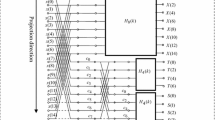Abstract
The split-radix algorithm (SR) is a highly efficient version of the successive doubling method (SD). Its application to the Fourier transform results in an algorithm that brings together the advantages of the radix 2 and radix 4 algorithms. In this work we present the generalization of the method that leads to the SR algorithm in the FFT and the implementation of a constant geometry (CG) version of it. In particular, we develop a CG algorithm of the successive doubling method that factorizes a sequence of lengthN intop sequences of lengthN/r and into (r−p)r of lengthN/r 2(r≥2, 0<p<r). After this, the method is generalized for its application to SRr, r 2,...r u algorithms, that is, to those based on the factorization of a sequence of lengthN intop 1 subsequences of lengthN/r, p 2 r of lengthN/r 2,...,p u r u−1 of lengthN/r u(p 1+p 2+...+p u =r). The results are applied to the implementation of a pipeline with identical stages and to a processor column.
Similar content being viewed by others
References
J.W. Cooley and J.W. Tukey, “An Algorithm for the Machine Calculation of Complex Fourier Series,”Math. Comput., Vol. 19, pp. 297–301, 1965.
P. Duhamel and H. Hollmann, “Split-Radix FFT Algorithm,”Electronics Letters, Vol. 20, No. 1, pp. 14–16, 1984.
L.R. Rabiner and B. Gold,Theory and Application of Digital Signal Processing, Prentice Hall, Englewood Cliffs, NJ, 1975.
M.T. Heideman and C.S. Burrus, “On the Number of Multiplications Necessary to Compute a Length-2n DFT,”IEEE Trans. Acoust., Speech, Signal Processing, Vol. ASSP-34, pp. 91–95, 1986.
C.S. Burrus and T.W. Parks,DFT/FFT and Convolution Algorithms, Wiley, New York, 1985.
H.V. Sorensen, D.L. Jones, C.S. Burrus, and M.T. Heideman, “On Computing the Discrete Hartley Transform,”IEEE Trans. Acoust., Speech, Signal Processing, Vol. ASSP-33, pp. 1231–1237, 1985.
H.V. Sorensen, D.L. Jones, M.T. Heideman, and C.S. Burrus, “Real-Valued Fast Fourier Transform Algorithms,”IEEE Trans. Acoust., Speech, Signal Processing, Vol. ASSP-35, pp. 849–863, 1987.
M.C. Pease, “An Adaptation of the Fast Fourier Transform for Parallel Processing,”J. Ass. Comput. Mach., Vol. 15, pp. 252–264, 1968.
E.L. Zapata and F. Argüello, “Application-Specific Architecture for Fast Transforms based on the Successive Doubling Method,”IEEE Trans. Signal Processing, Vol. 41, pp. 1476–1481, 1993.
F. Argüello,Application Specific Array Processors for Fast Orthogonal Transforms (in Spanish), Ph.D. Dissertation, University of Santiago de Compostela, 1992.
M.A. Richards, “On Hardware Implementation of Split-Radix FFT,”IEEE Trans. Acoust., Speech, Signal Processing, Vol. ASSP-36, pp. 1575–1581, 1988.
H.V. Sorensen, M.T. Heideman, and C.S. Burrus, “On Computing the Split-Radix FFT,”IEEE Trans. Acoust., Speech, Signal Processing, Vol. ASSP-34, pp. 152–156, 1986.
E.L. Zapata and F. Argüello, “A VLSI Constant Geometry Architecture for the Fast Hartley and Fourier Transforms,”IEEE Trans. on Parallel and Dist. Systems, Vol. 3, pp. 50–70, 1992.
G. Miel, “Constant Geometry Fast Fourier Transforms on Array Processors,”IEEE Trans. on Computers, Vol. 42, pp. 371–375, 1993.
Author information
Authors and Affiliations
Additional information
This work was supported by the Ministry of Education and Science (CICYT) of Spain under project TIC-92-0942-C03.
Rights and permissions
About this article
Cite this article
Argüello, F., Zapata, E.L. Constant geometry split-radix algorithms. Journal of VLSI Signal Processing 10, 141–152 (1995). https://doi.org/10.1007/BF02407032
Received:
Revised:
Published:
Issue Date:
DOI: https://doi.org/10.1007/BF02407032




